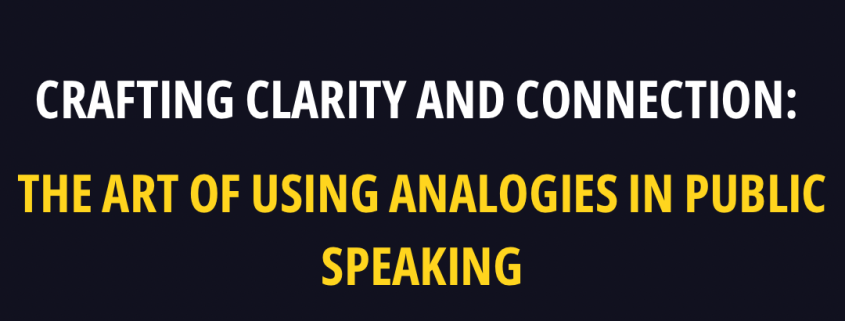Crafting Clarity and Connection: The Art of Using Analogies in Public Speaking
When George Lucas pitched the idea of his original plan for ‘The Adventures of Indiana Smith’ to Stephen Spielberg, he described the storyline to ‘Raiders of the Lost Ark’.
Spielberg loved the idea and described the movie concept as:
“James Bond without the hardware”.
They would go on to change the name from Indiana Smith to Indiana Jones and the rest is history.
Spielberg used the analogy of “James Bond without the hardware” to describe the concept of the movie in the most simplest terms.
In just 5 words, he was able to paint a picture of the complete concept of the character, movie themes and what the film will be about.
Analogies can be hugely powerful when we communicate and are a great public speaking skill.
Here are my 7 key reasons why using analogies can help with public speaking.
1. Analogies break down complex ideas
When delivering a speech or presentation, there needs to be a clear and obvious message for the audience.
But if that message is complex to explain, there’s a danger that the speaker uses jargon and technical language.
This can disengage an audience very quickly and often the message or idea can be completely lost on everyone.
An analogy can simplify the idea and make the message much clearer.
2. Analogies engages with the audience
Analogies only work if they’re relatable to the audience.
Tailoring the content is hugely important to creating engagement with an audience.
If the audience can’t relate to what is being said then they wont be engaged.
Sporting analogies are very popular but make sure they’re appropriate to the audience, or a home run might turn into an own goal… (see what I did there?).
3. Analogies improve retention of wha’t being said
A well delivered and descriptive analogy will be remembered.
people are much more likely to remember information that’s connected to something that they’re familiar with.
When Spielberg described his concept of Indiana Jones in the 1970’s, everyone knew who James Bond was.
4. Analogies help build a rapport with the audience
Rapport with an audience is finding a connection to create a positive relationship.
By using analogies that resonates with the audience’s background and experiences the audience will feel a stronger connection.
Tailoring speeches and presentations is essential when it comes to building rapport with an audience, and analogies that resonate instantly build connections between the audience and the speaker.
5. Analogies enhance persuasiveness and influence
If you need to be persuasive, an analogy can make a particular point easier to accept for the audience, especially if the analogy aligns with the audiences beliefs, values and experiences.
When communicating for change, using analogies that highlight the positives of moving forward and the negatives of going backwards can have a big impact.
6. Analogies clarify abstract concepts
If you’re concept is ‘as clear as mud’ in the mind of the audience, it would suggest that they don’t have much understanding on the concept that’s being communicated.
However, if you use analogies which helps the audience ‘unravel a complex knot’ then you’re making difficult to understand topics much clearer for the audience to get their heads round.
7. Analogies encourage creative thinking
Using analogies stimulates the imagination of the audience.
When the audience begin to think in pictures and images, it encourages them to think more creatively about the subject matter.
Creativity stimulates thinking which can create new ideas and motivates people to try new things or think differently.
Using analogies is a powerful tool when speaking publicly or delivering a presentation.
Tailoring content to the audience and using analogies that are relatable and easy to understand can help create engagement, simplify the message and connect with the audience.



